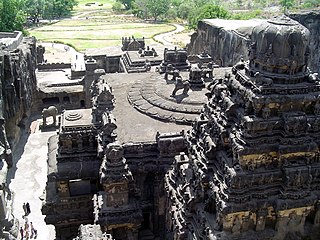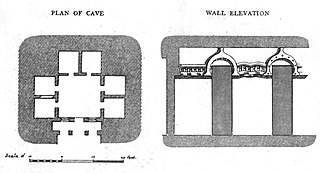
The Ajanta Caves are 30 (approximately) rock-cut Buddhist cave monuments which date from the 2nd century BCE to about 480 CE in Aurangabad district of Maharashtra state of India. The caves include paintings and rock-cut sculptures described as among the finest surviving examples of ancient Indian art, particularly expressive paintings that present emotion through gesture, pose and form.

Ellora is a UNESCO World Heritage Site located in the Aurangabad district of Maharashtra, India. It is one of the largest rock-cut monastery-temple cave complexes in the world, featuring Buddhist, Hindu and Jain monuments, and artwork, dating from the 600–1000 CE period. Cave 16, in particular, features the largest single monolithic rock excavation in the world, the Kailasha temple, a chariot shaped monument dedicated to Shiva. The Kailasha temple excavation also features sculptures depicting the gods, goddesses and mythologies found in Vaishnavism, Shaktism as well as relief panels summarizing the two major Hindu Epics.

Vihāra generally refers to a monastery for Buddhist renunciates. The concept is ancient and in early Sanskrit and Pali texts, it meant any arrangement of space or facilities for pleasure and entertainment. The term evolved into an architectural concept wherein it refers to living quarters for monks with an open shared space or courtyard, particularly in Buddhism. The term is also found in Ajivika, Hindu and Jain monastic literature, usually referring to temporary refuge for wandering monks or nuns during the annual Indian monsoons. In modern Jainism, the monks continue to wander from town to town except during the rainy season (Chaturmas), the term "vihara" refers their wanderings.

The Karla Caves, Karli Caves, Karle Caves or Karla Cells, are a complex of ancient Buddhist Indian rock-cut caves at Karli near Lonavala, Maharashtra. It is just 10.9 Kilometers away from Lonavala. Other caves in the area are Bhaja Caves, Patan Buddhist Cave, Bedse Caves and Nasik Caves. The shrines were developed over the period – from the 2nd century BCE to the 5th century CE. The oldest of the cave shrines is believed to date back to 160 BCE, having arisen near a major ancient trade route, running eastward from the Arabian Sea into the Deccan.

The Bagh Caves are a group of nine rock-cut monuments, situated among the southern slopes of the Vindhyas in Bagh town of Dhar district in Madhya Pradesh state in central India. These monuments are located at a distance of 97 km from Dhar town. These are renowned for mural paintings by master painters of ancient India. The use of the word "cave" is a bit of a misnomer, since these are not natural, but instead examples of Indian rock-cut architecture.

Mahadpronunciation (help·info) is a city in Raigad district(formerly Kulaba district) situated in the North Konkan region of Maharashtra state, India. It is located 108.5km from District's Headquarter Alibag, and 167km from Mumbai state capital of Maharashtra and Economic capital of India, towards Western Coast.

Indian rock-cut architecture is more various and found in greater abundance in that country than any other form of rock-cut architecture around the world. Rock-cut architecture is the practice of creating a structure by carving it out of solid natural rock. Rock that is not part of the structure is removed until the only rock left makes up the architectural elements of the excavated interior. Indian rock-cut architecture is mostly religious in nature.

Kondivali is a small village in Khed Taluka of Ratnagiri District in Maharashtra, India. The village is also known as 'Kondvil'. The main languages spoken here are Marathi and Konkani.

The Aurangabad caves are twelve rock-cut Buddhist shrines located on a hill running roughly east to west, close to the city of Aurangabad, Maharashtra. The first reference to the Aurangabad Caves is in the great chaitya of Kanheri Caves. The Aurangabad Caves were dug out of comparatively soft basalt rock during the 6th and 7th century.

The Shivneri Caves are artificial caves dug for Buddhist monks circa the 1st century CE. These are now famous tourist attractions located on Shivneri Hill, about 2 km Southwest of Junnar, India. Other caves around the city of Junnar are: Manmodi Caves, Lenyadri, and the Tulja Caves.

Gandharpale Caves, also called Mahad caves or Pandava Leni, is group of 30 Buddhist caves, 105 km south of Mumbai on Mumbai-Goa Highway near Mahad. The caves are located near the NH-17 and well connected by road.

Nenavali Caves, also Khadsamble Caves, are located at Sudhagad at Raigad, India. This is group of 37 Buddhist caves about 35 km from Pali, carved in first century B.C.

Shirwal Caves are a group of 15 Buddhist caves located in a small village called Shriwal, 48 km south of Pune, India.

Panhalakaji Caves are situated in the Ratnagiri district of Maharashtra state, about 160km south of Mumbai. This cave complex has around 30 Buddhist Caves. The Hinayana sect began carving caves in 3rd century AD, beginning with the stupa in the current Cave 5. The caves have inscriptions in Brahmi and Devanagari script. In the 10-11th century AD another Buddhist group, a Vajrayana sect, established cave 10 with their deities Akshobhya and Mahachandaroshana; and strengthened their practice in that region. Shiva and Ganpatya worshiping started at the site during Silahara rule.

The Guntupalle or Guntupalli Group of Buddhist Monuments is located near Kamavarapukota, West Godavari district, in the state of Andhra Pradesh in India. It is around 40 km away from Eluru. The rock-cut part of the site has two Buddhist caves, a chaitya hall and a large group of stupas. The chaitya hall has a rare carved stone entrance replicating wooden architecture, a simpler version of that at the Lomas Rishi Cave.

The Lomas Rishi Cave, also called the Grotto of Lomas Rishi, is one of the man-made Barabar Caves in the Barabar and Nagarjuni hills of Jehanabad district in the Indian state of Bihar. This rock-cut cave was carved out as a sanctuary. It was built during the Ashokan period of the Maurya Empire in the 3rd century BC, as part of the sacred architecture of the Ajivikas, an ancient religious and philosophical group of India that competed with Jainism and became extinct over time. Ājīvikas were atheists and rejected the authority of the Vedas as well as Buddhist ideas. They were ascetic communities and meditated in the Barabar caves. Still, the Lomas Rishi cave lacks an explicit epigraphical dedication to the Ajivikas, contrary to most other Barabar Caves, and may rather have been built by Ashoka for the Buddhists.

Saru Maru is the archaeological site of an ancient monastic complex and Buddhist caves. The site is located near the village of Pangoraria, Budhani Tehsil, Sehore District, Madhya Pradesh, India. The site is about 120 km south of Sanchi.

Yerphal Caves, also Yerphale Caves, are a small group of Buddhist caves located near Umbraj, Maharashtra, India. The caves were only discovered recently, in 1979. It is located not far from the Karad Caves.

The Khapra Kodiya Caves are part of the Junagadh Buddhist Cave Group. They are the oldest of the caves in the group. The caves, on the basis of scribbles and short cursive letters on the wall, are dated to 3rd-4th century BCE during the Emperor Ashoka’s rule and are the plainest of all the caves in the groups. These caves are also known as Khangar Mahal. They were carved in rock during the reign of Emperor Ashoka and are considered the earliest monastic settlement in the area. These caves are along the edge of the ancient Sudarshan Lake and a little outside Uparkot fort, to the north.
























